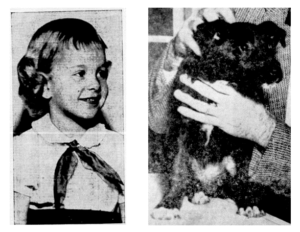
On February 25, 1957, Mary Jane Barker, a 4-year-old girl, vanished. A black Cocker Spaniel puppy belonging to her 6-year-old neighbour and friend Maria Frietta also vanished with her.
Assuming she had been kidnapped, her mother was convinced. Mr. and Mrs. Frank Barker pleaded with the alleged abductor to release Mary Jane, or “Putzey,” as they nicknamed her in an article from the Gettysburg Times. When it came to leaving instructions, Mrs. Barker stipulated that the assailant should drop her daughter off at “any church.” More than a thousand volunteers aided the police in their search for Mary Jane. It appeared like three sets of tracks near a stream had been produced by a man, a child, and a dog, and that this might be a sign.
As a kidnapping investigation, the police followed up on this and several other leads, believing that Mary Jane was the victim of a kidnapping. However, no progress was made in the case. In Bellmawr, New Jersey, a town of only 5,500 people in the 1950s, the case was a constant source of worry and bewilderment for residents.
Fortunately, the hunt was short-lived. When Maria Frietta and her parents moved into the uninhabited, the newly built house next door to their own on March 3, 1957, they thought it belonged to their distant aunt. When Maria finally unlocked a closet door, she was greeted with her pet, who was still alive and well. However, Mary Jane had been dead for days and was present at the scene of the crime.
The latch-knob on the inside of the closet had stuck, and that was what kept Mary Jane and the dog in the closet, according to the officers who examined the scene. Even an adult had a difficult time turning the handle on the interior of the closet, which was easily accessible from the outside. The inside of the door was scratched and scuffed, indicating that Mary Jane had made an attempt to flee. In their opinion, she had tried to kick her way out of the house.
Several further inferences were drawn following the autopsy. Since the day she vanished, Mary Jane had only consumed a small amount of chocolate milk. There was no evidence that she had been wounded or molested when she entered (or was placed in) the closet. Mary Jane’s death was attributed to a mixture of malnutrition, dehydration, and fear.
In the immediate aftermath of Mary Jane’s death, the most obvious question was how the dog survived (and appeared to be in good health). The animal was euthanized to examine the contents of its stomach in an effort to learn more about this. It’s really bad that I couldn’t locate any references to the test’s outcomes. Although the puppy was not housetrained, inspectors found no dog faeces or urine on any of the closet floors. Coprophagia – the dog devouring its own excrement – may be a possible explanation for the lack of hunger and messes in the closet.
Mary Jane and the dog were never heard by any of the dozens of persons who searched through the house that the closet was a part of. While it was assumed that the youngster was too terrified to make a sound, what about the pup? Considering that my dog isn’t afraid to bark when she needs to get into or out of a room, I find it strange that this dog remained silent for so long.
The Church of St. Frances de Sales hosted a memorial mass for Mary Jane, and Cornelius Devennel, the mayor of Bellmawr, issued an edict requiring all closet doors to have knobs that could be opened from the inside and the outside.
Authorities concluded that Mary Jane’s death was not the result of foul play after discovering her body and examining the area. This case is famous not for its mystery, but for its tragic outcome. My heart breaks when I think about that little girl and puppy, afraid and alone, confined in a small, dark closet. Two young, innocent lives were lost because of a basic design mistake, which raises the question, “Why?” in the face of reality’s severity and randomness. Is there any truth to this?